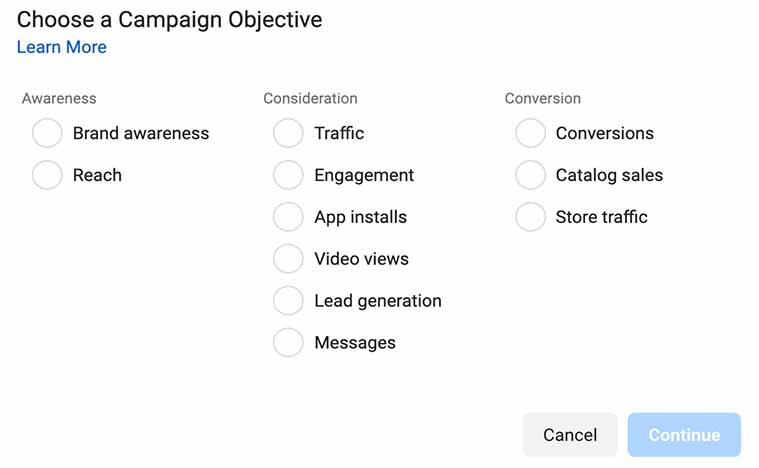PPC
Step-By-Step Facebook Ads Guide For Beginners In 2022
This Facebook Ads Guide For Beginners will show everything that is required to run a successful Facebook ad campaign in 2022. From the various types of Facebook ads that can be run to tips and tricks for running a successful ad campaign and everything in between. Today, more than ever before, it’s important to understand the best ways to leverage ads in social media.
Before getting started, it’s important to fully understand what the difference is between the types of ads and targeting. Consider the purpose of advertising and the goal that is being sought. Set a few goals such as “100 downloads or sales in the first month”. This guide will go in-depth to show the differences in Facebook ads and help the reader focus on orchestrating the very best ad campaigns that suit your specific needs. Let’s get started.
Types of Facebook Ads
Lead Ads
These ads tend to be ideal for mobile devices as their main purpose is to collect contact information. Ideal for gathering subscriptions to newsletters, signing potential customers up for trials of products, or for gathering and giving out more detailed information to potential customers.
 Dynamic Ads
Dynamic Ads
Ideal for targeting the right customer base to products. If someone visits a page and clicks on the product adding it to their cart, and later abandons the cart, it captures this information allowing an ad to be sent to them reminding them to complete their purchase.
Playable Ads
Playable ads encourage the user to interact with the content of the ad.
Image Ads
Consider the target audience and then create an image-based ad. Images can be simple but draw in the user. Target the audience accordingly by using the right content for the right audience. Example: Feature an eye-catching ad targeted to the right age bracket.
Video Ads
Video ads allow the user to see the product in action. These can be either stream ads that open automatically, or they can require the user to click and start the video. Ideal as a tutorial on how a product works. These tend to work well and bring in targeted sales.
Video Poll Ads
These ads are ideal for promoting brand awareness. Give the ad a poll and watch the sales roll in.
Collection Ads
Only offered for mobile devices, these ads allow the user to click on one of five products shown and purchase the product. Ideal for showcasing similar items of different colors, styles, or value.
Carousel Ads
Utilizing up to 10 images or 10 videos, these ads will showcase a product or a service. Ideal for showing the varying benefits of similar products or perfect to create a panorama image showing benefits of the product.
Slideshow Ads
Collect a variety of still photos, video clips, or text. These don’t require as much bandwidth as a full-fledged video so they’re ideal for those who may have intermittent signal or slower Internet signal.
 Instant Experience Ads
Instant Experience Ads
Also referred to as canvas ads, these work as a full-screen ad. They tend to load up to 15 times more quickly than other ads and are an ideal solution to linking to other ads or keeping the user’s attention.
Messenger Ads
For those who prefer to use Messenger, but may not frequent Facebook itself, these are perfect. All that is required is to mark the box for Messenger as the desired placement location. Be sure to select the “Facebook Feed” box as well for these. Users who use Messenger will then be targeted according to the target audience and see the ad.
Story Ads
In a study by Scientific American, it was discovered that as many as 72 percent of millennials won’t bother to rotate their phones and watch a widescreen video. A story ad is a full-screen video that is vertically-formatted to maximize the screen space. No need to rotate the phone to get the full picture as these ads are specifically designed to be watched in the vertical format.
Story Augmented Reality Ads
These ads utilize features such as filters and animation to allow users to interact. While this ad style is new to Facebook, as many as 63 percent of the United States Internet users state that they’ve tried these ads.
How To Advertise On Facebook In 2022
Choose An Objective
The first step to having a successful ad campaign on Facebook is to set up a Facebook Business Page. These are easy to create and can be done quickly. Once this page is set up, it’s easier than ever to set up a Facebook Ad via the Facebook Ads Manager or the Business Manager and create the ad campaign.
Step 1:
In the Facebook Ads Manager select the tab for Campaigns.
Click Create and get started with an ad campaign.
There are 11 objectives in marketing from which to choose. These 11 marketing objectives are as follows:
- App Installs: Entice people to install the app.
- Brand Awareness: Introduce the brand to the target audience.
- Catalog Sales: Connect the Facebook Ads to products in the catalog showing potential customers the ads for products.
- Conversions: Entice people to take action and subscribe to a list, newsletter, or make a purchase.
- Engagement: Reach a large audience to increase post interactions and likes. Increase awareness or attendance at events, or encourage people to take full advantage of an offer.
- Lead Generation: Generate leads by putting the contact information into a sales funnel.
- Messages: Utilize Messenger to reach the target audience on Facebook Messenger.
- Reach: Reach as many in the target audience as possible.
- Store Traffic: Direct customers who reside nearby brick and mortar stores to stop in and shop.
- Traffic: Direct traffic to a Website, an app, or to a Facebook Messenger conversation or group.
- Video Views: Target people who are most likely to watch your video ad.
It’s important to choose a campaign objective that is based upon the goals for the ad. Always keep in mind the goal for conversation objectives such as sales where it’s a pay per action vs. an objective such as traffic and views where it’s pay for impressions.
Depending on the objectives chosen, the next step will have slight changes based upon the objective.
Step 2:
Name The Campaign
Scroll down to where the ad campaign requires a name and select whether or not to set up an A/B split test. Here the option is whether or not to turn on budget optimization. This is very helpful if using multiple ad sets. To start with, most people leave this option in the off position.
For engagements, users must select whether they wish to focus on post engagements, event responses, or page likes.
Step 3:
Set Up The Ad Account
If this is already set up, there will be a button that will allow the user to advance to the next step.
If this isn’t set up, then the button will show “Set Up Ad Account”. Click and the user will be prompted to insert some information to create the ad account.
Make sure to select correctly here or another account will be required to change the choice.
Step 4:
Target The Audience
Name the ad campaign here.
Scroll down and begin building the target audience. Here it’s possible to customize the audience of those who have interacted with the business on or off of Facebook.
Select the target location, the target age, language, and gender of the audience. A box will open showing the size indicator on how many will likely see this targeted ad. Adjust it to set the potential goal accordingly.
There will also be a box showing potential page likes. Keep these in mind. Remember, these are estimates.
This is an excellent opportunity for detailing the target audience. Consider the goal of maximizing ROI (return of investment) and remember that there are a variety of ways to target the audience using the ad manager.
Detailed Targeting: Use for specifically including or excluding a potential audience based on interests, behaviors, and age.
Connections: Here it’s possible to target or exclude those who already have a connection to the pages being promoted. To reach a new audience select “Exclude people who like your page”. It’s also possible to target friends and friends of friends who may have an interest in the topic at hand.
Step 5:
Choose The Facebook Ad Placement
Scroll down and select where the ads should appear. There is also an option for Automatic Placements which is ideal for those who are new to Facebook Ad Marketing. Facebook will then automatically put the ads on Messenger, the Audience Network, and Instagram where they would most likely get the best results.
With more experience, many choose to place their Facebook ads in locations that they feel will be more likely to reach the targeted audience. Here are some options for the placement of ads:
Device: Mobile, or desktop, or both mobile and desktop.
Platform: Instagram, Messenger, Audience Network, or Facebook.
Placements: In feeds, messages, in articles, apps, external sites, in-stream videos.
Specific Mobile Devices And Operating Systems: Android, iOS, Feature phones, and all other devices.
Step 6:
Set Budget And Schedule
Now it’s time to determine the amount of money to spend on Facebook ad campaigns. Here it’s possible to choose a daily budget or a lifetime budget. Set start and end dates if scheduling for the future and then select whether or not to make it live immediately or schedule it to start for a later date.
It’s also optional to use cost and bid controls to cap the amount per action in lieu of the overall campaign. It’s possible to go into fine detail about the ad budget.
Always remember that when running the Facebook paid ads on schedule it will be a very efficient way to spend the budget. This is ideal because it will focus the ad mostly when the target audience is most likely to be online.
Click continue when satisfied that the right selections have been made.
Step 7:
Create The Ad
Select the ad format of choice and enter the required text and any media components for the ad. The available formats will vary based upon the specific campaign objective that was selected at the start of the process.
There is a preview tool at the bottom of the page to ensure that the ad looks right. Be sure to check the ad for potential placement on desktop news feeds, proper column alignment, and mobile devices. When happy with the results click the green “Confirm” button to submit the order. Facebook will send out an email notification when the ad is approved.
Facebook Ad Specs: Requirements
Many details need to be kept in mind while setting up images and videos for Facebook ads. There are frequent changes in algorithms and requirements. Details can change often and it’s important to keep up to date on the requirements.
Facebook has also set up 16 free templates to use on Facebook that can greatly assist in creating ads.
Text And Objective Specs For Ads On Facebook
To create successful Facebook ads, it’s important to stick to the recommended character counts. Anything that exceeds these limits will be cut off.
It’s also vital to understand the types of Facebook ad works for the various ad campaign objectives.
Images
Headline: 25 characters
Link Description: 30 characters
Body Text: 125 characters
Campaign Objectives: All ad campaigns except video views
Videos
Headline: 25 characters
Link Description: 30 characters
Body Text: 125 characters
Campaign Objectives: All ad campaigns except catalog sales
Collection
Headline: 25 characters
Link Description: Not applicable
Body Text: 90 characters
Campaign Objectives: Catalog sales, conversions, store traffic, traffic
Carousel
Headline: 25 characters
Link Description: 20 characters
Body Text: 125 characters
Campaign Objectives: All ad campaigns except engagement and video views
Slideshow
Headline: 25 characters
Link description: 30 characters
Body text: 125 characters
Campaign objectives: All ad campaigns
Instant Experience
Text: Blocks of text of 500 words each.
Campaign Objectives: All ad campaigns except lead generation, catalog sales, and messages
Messenger Inbox
Headline: Not Applicable
Link Description: Not Applicable
Body Text: 125 characters
Campaign Objectives: App installs, catalog sales, conversions, messages
Facebook Stories
Text: With no set character count, you should aim to have 250 text-free pixels at the top and bottom of ads.
Campaign objectives: Messages, store traffic, and catalog sales
5 Tips For Running Facebook Ad Campaigns
1. Experiment Targeting Audience
Narrow the target audience and gradually widen the target slowly adding one category at a time. A good example is:
Vineyards
after a few weeks add in the following ideas one at a time until the target audience has been increased:
Wine Tours
Wine Tasting
Foods that pair well with wine
Best wine glasses
By creating different niches the target audience is gradually widened to include similar likes and dislikes.
2. Use The Facebook Pixel
This is a code that can play a huge part in the Facebook ad campaigns. Place this code on the website and it gives the ability to track conversions and send ads to those who have visited the page.
3. Use High-Quality Pictures And Video
If unable to gather high-quality pictures and videos, find sites where they can be uploaded such as free stock photo sites.
4. Test, Test, & Test More!
Test and retest ads frequently. Stay up to date with ads.
5. Track And Optimize
Monitor campaigns closely and adjust them as required to continue high ratings.
Facebook Ad Ideas To Get Started
- Convert proven content into a video. Adapt content to showcase products or services.
- Drive direct sales. Target the right audience and the sales should flow in effortlessly.
- Think outside the Internet to include Brick and Mortar sales.
As the largest social media network in the world, Facebook allows users the opportunity to create a myriad of different ads that will reach target audiences and help you achieve your business’s goals. Utilizing Facebook’s micro-targeting it’s easier than ever to reach your exact target audience. Putting your message in front of people that will actually be interested in your product or service will help you reach more customers and most importantly convert those customers. This in-depth step-by-step Facebook Ads Guide For Beginners is a great way to get your next Facebook Marketing campaign up and running.
Brett Heimann is a marketing & advertising professional with 10 years of experience. He's the founder of MarketingAgency.com and contributes to other publications such as; Entrepreneur, Thrive Global, and StockMarket.com. His passion for digital marketing began after graduating with a B.S.B.A in business administration and finance in 2013. After completing college, he went on to become an entrepreneur in the marketing and finance space. Brett loves the ability to deliver to his readers engaging and educational content that can be easily consumed by the reader. He enjoys writing about a wide variety of marketing topics such as; Search Engine Optimization (SEO), Paid Advertising (PPC), E-Commerce, and Lead Generation For SMBs to name a few. Brett, a South Florida native, enjoys spending time with his wife and two sons outdoors and is a big basketball and MMA fan.



































